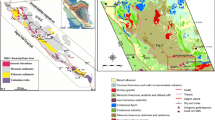Abstract
Exploration for epithermal Au has been active lately in the Aegean Sea of the eastern Mediterranean Basin, both in the islands of the Quaternary arc and in those of the back-arc region. The purpose of this study was the structural mapping and analysis for a preliminary investigation of possible epithermal gold mineralization, using remotely sensed data and techniques, structural and field data, and geochemical information, for a specific area on the Island of Lesvos. Therefore, Landsat-TM and SPOT-Pan satellite images and the Digital Elevation Model (DEM) of the study area were processed digitally using spatial filtering techniques for the enhancement and recognition of the geologically significant lineaments, as well as algebraic operations with band ratios and Principal Component Analysis (PCA), for the identification of alteration zones. Statistical rose diagrams and a SCHMIDT projection Stereo Net were generated from the lineament maps and the collected field data (dip and strike measurements of faults, joints, and veins), respectively. The derived lineament map and the band ratio images were manipulated in a GIS environment, in order to study the relation of the tectonic pattern to both the alteration zoning and the geomorphology of the volcanic field of the study area. Target areas of high interest for possible mineralization also were specified using geochemical techniques, such as X-Ray Diffraction (XRD) analysis, trace-element, and fluid-inclusion analysis. Finally, preliminary conclusions were derived about possible mineralization, the type (high or low sulfidation), and the extent of mineralization, by combining the structural information with geochemical information.
Similar content being viewed by others
REFERENCES
Argialas, D., Stearns, R., and Shahrokhi, F., 1988, Mapping and significance of Landsat and gravity lineaments in west Tennessee: Jour. Aerospace Engineering, Am. Soc. Civil Engineers, v. 1, no. 2, p. 74–87.
Berger, B. R., and Eimon, P. I., 1982, Comparative models of epithermal silver-gold deposits: Soc. Mining Engineers of AIME (Littleton, Colorado), preprint., p. 82–113.
Biedny, D., and Monroy, B., 1991, Official photoshop handbook: Bantam, New York, p. 423.
Clark, A. L., Berg, H. C., Cobb, E. N., Eberlein, G. D., MacKevett, Jr., E. M., and Miller, T. P., 1974, Metal provinces of Alaska: U. S. Geol. Survey Misc. Inventory Map I-384, scale: 1:5,000,000.
Earth Resource Mapping Inc, 1997, ER Mapper 5.5-Applications Manual.
Ford, G. E., Algazi, V. R., and Meyer, D. I., 1983, A non-interactive procedure for land use determination: Remote Sensing of Environment, v. 13, no. 1, p. 1–16.
Gupta, R., 1991, Remote sensing geology: Springer-Verlag, Berlin, 233 p.
Haralick, R. M., 1984, Digital step edges from zero crossing of second directional filters: IEEE Trans. Pattern Analysis and Machine Intelligence, PAMI-6, p. 58–68.
Hecht, 1971, Geological map of Hellas, Lesvos Island: Inst. Geological and Mining Research, Hellas, map sheets Mithymna and Agia Paraskevi, scale 1:50.000.
Jain, A. K., 1989, Fundamentals of image processing: Prentice Hall, Englewood Cliffs, New Jersey, p. 342–357.
Jensen, J., 1996, Introductory digital image processing: Prentice Hall Series in Geographic Information Science, Englewood Cliffs, New Jersey, p. 159–165.
Karfakis, I., 1991, Applications of remote sensing techniques in geology and mineral exploration of the Eastern Rhodope Region, Greece: unpubl. doctoral dissertation, Univ. Patras, Greece, 185 p.
Karfakis, I., and Doutsos, T., 1995, Late orogenic evolution of the Circum-Rhodope Belt, Greece: N. Jb. Geol. Paläont. Mh., H. 5, Stuttgart, p. 305–319.
Lindgren, W., 1933, Mineral deposits: McGraw-Hill Book Co. Inc, New York-London, 930 p.
Mercier, J. L., Simeakis, K., Sorel, D., and Vergely, P., 1988, Extentional tectonic regimes in the Aegean basins during the Cenozoic, in The structural and sedimentary evolution of the Neotectonic Aegean Basins: Basin Research, submitted.
Novak, I. D., and Soulakallis, N., 2000, Identifying geomorphic features using Landsat-5 TM data processing techniques on Lesvos, Greece: Geomorphology, v. 34, no. 1–2, p. 101–109.
Pe-Piper, G., 1980, The Cenozoic volcanic sequence of Lesbos, Greece: Z. dt. geol. Ges., v. 131, p. 889–901.
Pratt, W. K., 1991, Digital image processing: John Wiley & Sons, New York, 698 p.
Rigol, J. P., and Chica-Olmo, M., 1998, Merging remote sensing images for geological-environmental mapping: application to the Cabo de Gata-Nijar Natural Park, Spain: Environmental Geology, v. 34, no. 2–3, p. 194–202.
Rokos, D., Mavrantza, R., Vamvoukakis, C., St.-Seymour, K., Karfakis, I.,Kouli, M., and Lamera, S., 2000, Integration of remote sensing, geological and geochemical techniques into a GIS environment for the identification of tectonic and volcanic structures: Lesvos Island, Aegean Sea, Hellas: Fourteenth Intern. Conf. Applied Geologic Remote Sensing (LasVegas, Nevada), p. 161–168.
Russ, J. C., 1992, The image processing handbook: CRC Press, Boca Raton, Florida, 445 p.
Sabins, F. F., 1997, Remote sensing: principles and interpretation: W. H. Freeman & Company, New York, p. 366–371.
Sillitoe, R. H., 1974, Tectonic segmentation of the Andes: implications for magnetism and metallogeny: Nature, v. 250, no. 5467, p. 542–545.
Sillitoe, R. H., 1993, Gold-rich porphyry copper deposits: geological model and exploration implications, in Kirkham, R. V., Sinclair, W. D., Thorpe, R. I., and Duke J. M., eds, Mineral Deposits Modelling: Geol. Assoc. Canada, Spec. Paper 40, p. 456–478.
Simeakis, K., Mercier, J. L., Vergely, P., and Kissel, C., 1989, Late Cenozoic rotations along the North Aegean trough fault zone (Greece). Structural constraints, in Kissel, C., and Laj, C., eds, Paleomagnetic Rotations and Continental Deformation, Kluwer Acad. Publ., Dordrecht, p. 131–143.
White, N. C., and Hedenquist, J. W., 1995, Epithermal gold deposits: Soc. Economic Geology Newsletter, v. 23, no 1, p. 9–13.
Woldai, T., 1995, Lithologic and structural mapping in a vegetated low-relief terrain using multiple-source remotely sensed data: a case study of the Calañas area in southwest Spain: ITC Journal, v. 2, p. 95–114.
Rights and permissions
About this article
Cite this article
Rokos, D., Argialas, D., Mavrantza, R. et al. Structural Analysis for Gold Mineralization Using Remote Sensing and Geochemical Techniques in a GIS Environment: Island of Lesvos, Hellas. Natural Resources Research 9, 277–293 (2000). https://doi.org/10.1023/A:1011505326148
Issue Date:
DOI: https://doi.org/10.1023/A:1011505326148




